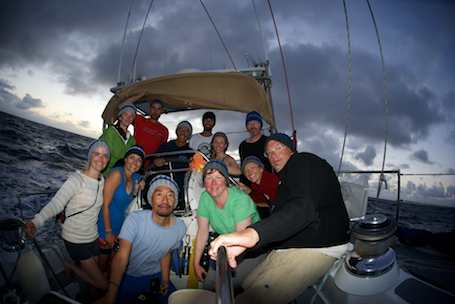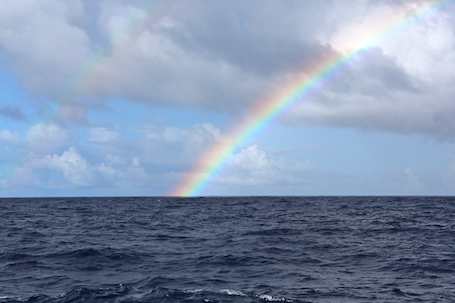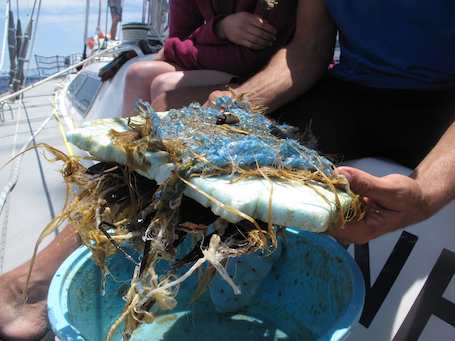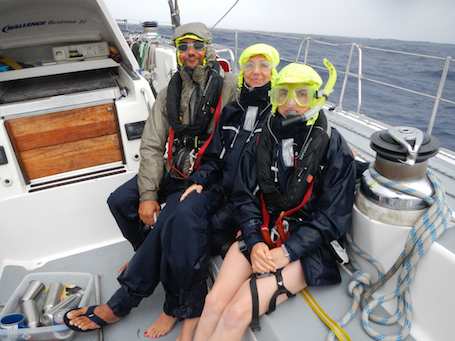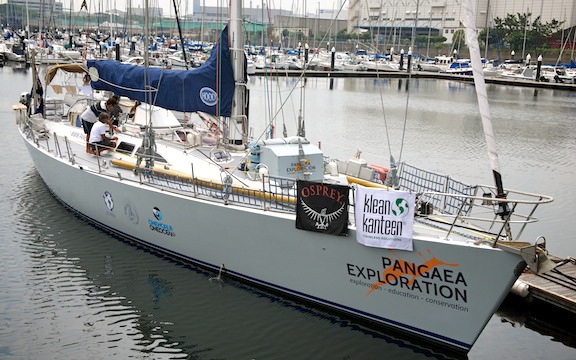Plastic soup du jour
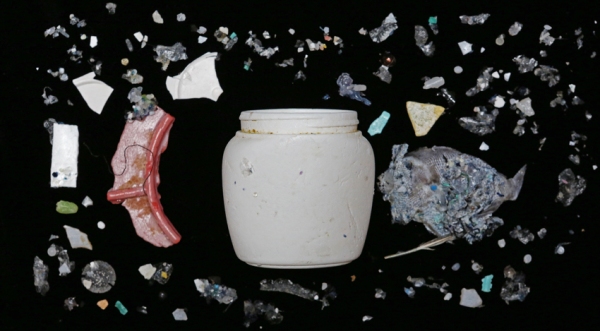
The contents of a sampling net left in the water for 24 hours. From left to right: a red plastic fragment, a white plastic jar and a trigger fish. The surrounding particles include plastic pieces and marine life.
On our penultimate night at sea, Marcus recapped our findings from the past four weeks. During the 3,800 mile expedition, we observed over 690 items floating at sea and collected hundreds more fragments from 29 trawls.
From bottle caps, toothbrushes, plastic fragments, buoys and rope to a Japanese fishing boat, we’ve watched a dizzying array of debris float past the ship.
Some of it, like the tatami mat and Bridgestone tire, were almost certainly swept away during the tsunami. Others, like the hundreds of plastic fragments Marcus collected in the manta trawls, could have been in the ocean for decades before we stumbled upon them.
Mandy Barker, a crew member and artist who has been photographing the debris for a forthcoming collection, has taken photos of the fragments we’ve retrieved in Marcus’ high speed trawl.
Once Marcus drops the trawl into the water, he leaves it there for 24 hours and then empties the contents onto a mesh screen. Mandy has been taking those fragments and photographing them on a piece of black velvet as a way to record what we’ve seen.
The images are stunning, not least for their ability to show how plastic out numbers marine life in each sample.
As a parting gift, Marcus poured samples into eleven jars for each of us to take home. Mine is sitting, wrapped in a plastic diaper, in my carry-on bag.
I imagine where I’ll put it when I get home—perhaps on my bookshelf next to copies of The Great Gatsby, The Better Angels of Our Nature and a collection of Lorrie Moore’s short stories or maybe on my nightstand or on a cool dry shelf in my closet.
There’s really no good place to store a jar full of seawater and marine debris, that haunting reminder of the millions of pieces of trash that drift into the ocean each year. Some of it is undoubtedly mine, a guilt I cannot surmount nor easily assuage.
Appeasing the wind gods
We’ve finally gotten sunny weather! The rainbows above the horizon and the red tailed tropic birds overhead remind us that we’re quickly approaching the Hawaiian Islands.
Our bunks no longer smell like wet dog and we’ve all managed to dry some of our clothes. It’s been nice having non-pruney fingers and not getting drenched in the rain while steering during nighttime watch.
A few nights ago we assembled on deck for an impromptu wind ceremony since the wind hasn’t been in our favor. We need northern winds in order to sail east toward Maui.
While Rodrigo steered and Stiv chanted, the rest of the crew started banging on stainless steel water bottles, plastic buckets and metal pans. Shannon even played her harmonica and it was quite comical to see everyone rocking out on dishware in hopes of changing the wind direction.
The crew is anxious to take warm showers, eat fresh vegetables and Kelvin says he plans to kiss the ground the moment we arrive.
The first thing I plan to do when I get back? Go for a very very long run. And maybe down a cold glass of beer.
Uncovering a broken tatami mat
It was one of the most unrecognizable pieces of debris I’d ever seen. From broken toilet seats to bottle cap fragments I’ve seen some pretty degraded pieces of trash in the Pacific, but this layered mat of plant fiber, plastic and foam didn’t resemble anything I recognized.
A woven layer of rush—a waterside plant with stem-like leaves—was topped with a mint green chunk of foam. The foam was covered by another piece of woven rush and held together by a layer of thin blue plastic, no thicker than a grocery bag.
Marcus sent an email to his Japanese contacts asking about the chunk of debris. Within two days, he received an email from Kana Jones of Dance for Oceans saying it’s a type of Japanese flooring called a tatami mat.
Traditional tatami mats have compressed straw inside but modern mats have polyethelene foam sandwiched between woven rush sheets. It was unbelievable to look at this frayed piece of fiber and plastic and realize that it was once inside someone’s home before it was ripped away by the tsunami.
It’s thoughts like these that make me uneasy. I wonder if we’re upending historical fragments that were never meant to be recovered.
Most of the tsunami debris in the Pacific will remain untouched since it’s sitting at the bottom of the ocean. But floating debris will be treated as a spectacle for years before the last trickle washes ashore. Even now, sitting on deck, watching plastic fragments float by the ship, I wonder where they’ll end up and who will find them.
We’ve collected so much debris that it’s piling up on the back of the ship. Buoys and rope and drift net are squashed between plastic buckets and crates and large unidentifiable fragments covered with barnacles and algae.
Marcus is looking forward to combing beaches that are littered with plastic when we arrive in Maui. It’s hard to find a place that isn’t touched by pollution, that isn’t littered with trash. In the 20 days we’ve been at sea we’ve yet to find a place that is nothing but wind and ocean waves.
Singing in the rain
My crewmate Daniella climbed on deck holding a bowl of tortillas, rice and beans just as a wave crashed onto the ship and soaked her dinner.
“What should I do?” she asked.
“Throw it overboard,” I laughed. I knew there was no salvaging a dinner that was full of salty seawater.
Only a few days earlier Tracey was drenched so thoroughly by a wave that her life vest inflated. Today the net on the high-speed manta trawl ripped off after being tossed around in the water and the closet where we keep our foul weather gear has started to smell like a high school men’s locker room. The stench was so nauseating that Laura had to run up on deck—the smell literally made her sick to her stomach. And Kelvin, who we’ve lovingly dubbed the Korean Tiger, is still seasick after 15 days of sailing. He stopped eating and we think he’s lost at least 10 pounds. He reassured us that he can make it to Hawaii and we’ve finally managed to get him eating a small bowl of rice and scrambled eggs each day. His wife is going to kill us. So it’s been an intense two weeks at sea. Through it all we’ve found ways to laugh at the insanity of the trip. Last week Jesse, the first mate, tied a frayed piece of rope to my coveralls and I walked around like a monkey with a tail for five minutes before I realized what he’d done. Marcus, Shannon and I sported goggles during a particularly rainy watch yesterday and I joked that we should have a wet weather boat camp, where we do crunches and lunges while being soaked by seven-foot swells. Jesse and our captain Rodrigo have taken turns hiding a small stuffed animal that Tracey brought on board. The little orange bird has been tied 30 feet in the air to the ship’s flag line, wedged into the freezer and stuffed into a coffee mug. Right now he’s dangling from a metal rail above the sink, with a note that says, “please do not choke the sparrow.” You get to know people extremely well when you spend three weeks at sea with them. And for a trip that’s been this tumultuous I can’t imagine a better crew to be with. Within the first 24 hours I’d been feed an amazing dinner, loaned a dry t-shirt and had my hair tied back while I got seasick on deck—thanks Daniella, I owe you one.
Washed out to sea
 The entire crew was on deck looking for the whale Tracey had just spotted and I immediately saw a white object near the horizon. Thinking it was spray from the whale’s blowhole, I wondered why it looked so solid. As we sailed toward the surfacing animal there was something blue near its head. Then we realized it wasn’t a whale at all—it was half of a derelict boat.
The entire crew was on deck looking for the whale Tracey had just spotted and I immediately saw a white object near the horizon. Thinking it was spray from the whale’s blowhole, I wondered why it looked so solid. As we sailed toward the surfacing animal there was something blue near its head. Then we realized it wasn’t a whale at all—it was half of a derelict boat.
In the cerulean water surrounding the boat, over fifty fish swam around the enormous piece of debris. Some of them—bright yellow and black striped reef fish—are hundreds of miles from their natural habitat. The boat was torn in half and the inside was painted a vibrant turquoise—the blue that we’d seen in the distance. Along both sides of the boat were Japanese characters and on one side were the numbers 13-16. I was surprised at the lack of algae encrusting the boat, which could be another sign that the boat hasn’t been in the water very long.I had the startling realization that as we gaped and gawked, took photos and videos of the boat, its owners may be crossing a busy street in Japan, cooking a pot full of noodles at home or going about any number of routine daily tasks, their boat a long forgotten memory, or the far worse thought, that they might not be doing anything—that their voyage in this boat was their last. It’s strange to look at remnants of towns that have been razed or to collect objects that were important parts of people’s lives. We’ve only sampled a fraction of the debris field and detritus from the Tohoku earthquake will remain at sea for years until other seafarers like us stumble upon them.
We’re like tourists in a forgotten city, a city whose landscape is transformed each day with the movement of the waves. This watery Pompeii, eloquent but impermanent, conveys the somber aftermath of natural disasters and how easily we wipe them from memory when another story makes front page headlines.
This wasn’t the first tsunami off Japan’s coast and it won’t be the last. But swimming inside that boat, wondering about its owners somehow made it real. The question is: how do we turn this memory into a catalyst to act, to move, to adapt before the next disaster is upon us.
Made in Japan
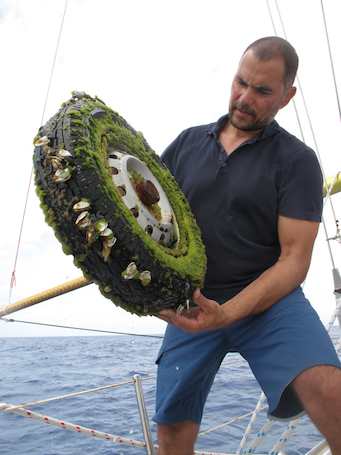
Marcus Eriksen holds a Bridgestone tire covered in algae, gooseneck barnacles and small golden crabs found in the Japanese tsunami debris field.
On Tuesday afternoon I awoke suddenly when I heard the rumble of feet and the crew shouting, “we have to turn around!”I grabbed my camera and ran on deck to see Tracey, an entrepreneur from Hong Kong, pointing toward a black speck in the distance—a floating tire. Rodrigo, our captain, turned the boat around and Marcus grabbed a mesh pool skimmer and stood at the front of the boat, straining his eyes to look for the bobbing black object. I thought we’d never find it again but with the entire crew on deck we spotted it and Marcus leaned precariously over the port side of the boat to heave the tire on board. Water poured from the tire and small golden crabs fell from the floating piece of rubber. The rusted metal rim revealed the tire’s origin: made in Japan. Although it’s impossible to definitively trace the tire back to the tsunami, those three words are extremely telling. If it was made in Japan it’s possible the tire was in the country before the tsunami hit. It’s still inflated and only slightly rusted, which means it probably hasn’t been in the water for more than a year or two, which puts it within the time frame of the tsunami. The bearing cap is still on the rim, which means it was probably fitted to a car at some point, probably a truck as the rim says, “light truck.” This is the largest piece of debris we’ve hauled on board and we have five or six more days in the debris field before we head south for Hawaii (I’ll update you on some of the other things we found in another post). As I write this Jesse, the ship’s first mate, is cooking Mahi Mahi on the stove; he caught the fish about an hour ago and the smell of butter and herbs is warming the air. With twelve people on board and a diminishing supply of fresh food, the white fish will be gone within the hour.
500 messages adrift at sea
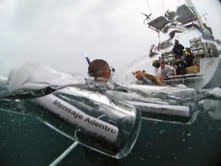 I was finally able to get in the water! The cold damp weather hasn’t cleared but the rain subsided long enough for Marcus and I to jump off the stern and release 500 messages in tiny glass bottles. Each harmonica-sized bottle contains a scroll with the words “message inside” written in eight languages. The paper slips instruct finders to email 5Gyres, and Marcus guesses it’ll be years before he hears anything about the messages he sent out to sea. He says the bottles will test professor Nikolai Maximenko’s predictions about how the wind and water currents have pushed the tsunami debris east. As I bobbed along the waves behind the boat—one hand holding my underwater camera and the other tightly grasping a rope we’d attached to the stern—I watched Marcus hoist a large cardboard box full of bottles above his head. As soon as he dumped the clanking bottles into the water they scattered behind the boat and it was only a few minutes before most of them disappeared from sight. I have mixed emotions about releasing these bottles. They could provide valuable insights into wind and water patterns but there’s still the unavoidable fact that we’re putting more debris into the ocean. I wonder, with all this plastic pollution research, how much good we’re doing and how much harm. I remember standing at the stern of Captain Moore’s ship Alguita in the middle of the garbage patch three years ago; he captured an enormous tangle of rope and nets and hoisted it on board. The fish that lived beneath the netball were swimming behind the boat as if they expected us to return their makeshift home. Instead, we revved up the engine and started motoring away. The fish frantically swam after us; some of the reef fish and were unlikely to survive 1,000 miles from their natural habitat off the coast of Hawaii. When I tell that story people still gasp and it hasn’t lost its affect on me. There’s always a trade-off and today I still wonder which one we’re making.
I was finally able to get in the water! The cold damp weather hasn’t cleared but the rain subsided long enough for Marcus and I to jump off the stern and release 500 messages in tiny glass bottles. Each harmonica-sized bottle contains a scroll with the words “message inside” written in eight languages. The paper slips instruct finders to email 5Gyres, and Marcus guesses it’ll be years before he hears anything about the messages he sent out to sea. He says the bottles will test professor Nikolai Maximenko’s predictions about how the wind and water currents have pushed the tsunami debris east. As I bobbed along the waves behind the boat—one hand holding my underwater camera and the other tightly grasping a rope we’d attached to the stern—I watched Marcus hoist a large cardboard box full of bottles above his head. As soon as he dumped the clanking bottles into the water they scattered behind the boat and it was only a few minutes before most of them disappeared from sight. I have mixed emotions about releasing these bottles. They could provide valuable insights into wind and water patterns but there’s still the unavoidable fact that we’re putting more debris into the ocean. I wonder, with all this plastic pollution research, how much good we’re doing and how much harm. I remember standing at the stern of Captain Moore’s ship Alguita in the middle of the garbage patch three years ago; he captured an enormous tangle of rope and nets and hoisted it on board. The fish that lived beneath the netball were swimming behind the boat as if they expected us to return their makeshift home. Instead, we revved up the engine and started motoring away. The fish frantically swam after us; some of the reef fish and were unlikely to survive 1,000 miles from their natural habitat off the coast of Hawaii. When I tell that story people still gasp and it hasn’t lost its affect on me. There’s always a trade-off and today I still wonder which one we’re making.
Getting our sea legs
We made it out of Yokohama Marina! We set sail under sunny skies and the crew was all on deck, ecstatic that we were finally under way! We motored out of the marina and our enthusiasm seemed unassailable. Moments later, I was in the galley when I saw our ship’s first mate Jesse filling up a glass of water and heading back up on deck pausing to say, “we’ve got some sick puppies upstairs.” He was right, Shannon, an affable coordinator for the California Coastal Commission and Laura, a student from Switzerland were both curled up on deck trying to overcome their nausea. And Kelvin, a videographer from Korea who entertained the crew last week with his vibrant stories of Korean culture, the best way to make kimchi and why Korean ramen beats Japanese ramen, didn’t leave his bunk for the first 48 hours we were at sea. The sun soon gave way to rain, and heavy gusts of wind created large waves that rocked the boat fiercely from side-to-side, making the seasick crew even more queasy. I’m hoping for good weather tomorrow and that the crew starts to recover. We’re only a few days into the trip and so much has happened. This voyage is definitely going to be an adventure.
Setting sail for the tsunami debris field
The voyage hasn’t even started and already it’s been an adventure. After discovering a typhoon making it’s way up the Japanese coastline we decided to stay in the Yokohama Marina south of Tokyo to let the storm pass.
I’m so glad we did because two rowers were stranded while making their way across the Pacific and have just been rescued by the Japanese Coast Guard.
We depart today and will spend three weeks on a 72-foot sailboat traveling from Japan to Maui to track the one million tons of tsunami debris headed toward the west coast of Canada and the U.S.
I’ll be writing about what we find for The New York Times, Civil Beat and possibly even the Boston Globe, whose science editor is interested in a story.
The expedition is organized by 5Gyres, Algalita and Pangaea Exploration and the 13-passenger crew is comprised of scientists, ocean conservationists and documentarians.
A major goal of the voyage is to see what’s out there, how much we encounter and whether any of it is hazardous. Most scientists I’ve spoken with, including scientists from Woods Hole Oceanographic Institution and NOAA say it’s unlikely that the debris is radioactive since plastic—which will comprise most of the debris field—doesn’t absorb radioactive compounds. Also, most of the debris had dispersed before the nuclear reactors at Fukushima started leaking.
Already, beachcombers in Alaska and California have found debris strewn on local shores. Recent news reports have identified everything from a floating ghost ship to a soccer ball that have made their way across the Pacific—the soccer ball was even returned to it’s owner.
NOAA is accepting emails from anyone who finds heirlooms that could be traced back to survivors of the tsunami.
We’ll be sampling the debris using a manta trawl, free-diving off the debris and we’ll be taking water samples for scientists back at Woods Hole who will analyze the liquid for radioactive isotopes like cesium, something you may have read about recently when news outlets across the U.S. reported that bluefin tuna caught off the coast of California contain low levels of cesium.
I’ll be at sea for three weeks with limited internet access but you can follow the voyage here on my blog or on Twitter @thegarbagegirl.
14 journalists, 12 hours, one midnight adventure
At midnight I was pushing a 55 passenger van up the side of a hill. This adventure is just one of many I’ve experienced this week as an IJNR fellow. The Institutes for Journalism and Natural Resources selects a handful of journalists each year to spend a week in the field exploring unique challenges facing the natural environment.
Our amiable group is looking at energy issues in Northern New Mexico and Southern Colorado. En route to Colorado last night we got caught in a snow storm and after the chains on our tires broke, all 14 journalists tried in vain to push the van up the hill.
Though we managed to nudge the bus a few inches, it was ultimately our heroic bus driver, Dick Sandlin, who got us all the way to Ignacio, CO. A bus ride that started at 2:15pm ended at 2:30am and I’m certain it was the gummy bears and my boisterous colleagues that kept me going!
The best part about being on the-longest-bus-ride-ever with a group of journalists is that it was well documented! Our fiasco was mentioned in the Durango Herald and photojournalist Michael Kodas published a great post about our entire trip thus far.
The last photo on his post is exactly how I felt when I realized we’d be trapped on the bus for 10+ hours without Internet! But I have to say, this week has been phenomenal and it’s only Tuesday.
